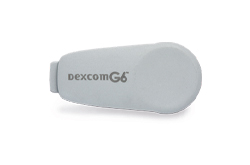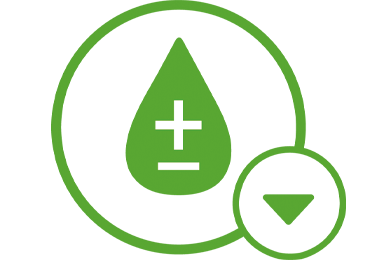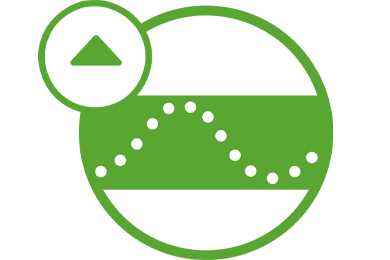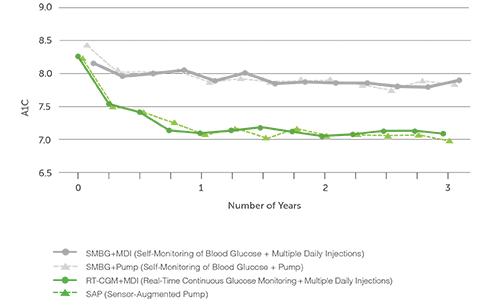Continuous glucose monitoring provides a more complete picture of a patient’s glucose levels, compared to what you can obtain from a blood glucose meter (BGM). More frequent access to glucose insights leads to more effective diabetes management, for you and your patients.1,2

Smart devices sold separately†
Watch the video below to learn how the Dexcom G6 CGM System can give patients the power of glucose at a glance.

The Difference is in the Data

Some people with diabetes may struggle to understand how diet and exercise play a role in their treatment, or how to effectively titrate insulin accordingly.
But with continuous glucose readings from Dexcom G6, users can see a complete view of their glucose levels in real time, including historic and current glucose values and rate of glucose change, without requiring action from the user providing users with actionable information, over and above a single BGM reading.
Continuous Insight, Day and Night
Dexcom G6 helps minimise the guesswork derived from making diabetes treatment decisions based on a BGM reading alone and requires zero fingersticks* or scanning to access glucose data, helping to empower patients to self-manage their diabetes.

Primary CGM Components
The Dexcom G6 CGM System consists of four main components:

Auto-applicator
Provides simple sensor insertion at the push of a button. A patient can apply the sensor on their own by following the instructions for use.

Sensor
Monitors interstitial glucose levels through a small wire inserted just underneath the skin, sending a signal to the transmitter (10-day lifespan).

Transmitter
Fastened on top of the sensor; sends data wirelessly to the wearer's compatible display device† (3-month lifespan).

Display device
Allows patients to view their real-time glucose data and trends. Dexcom G6 also enables patients to receive a suite of alerts including a predictive Urgent Low Soon alert, an Urgent Low alarm, and other notifications on their display device,† which can help warn them of high or low glucose levels.
The Benefits of CGM for Insulin-Using Patients
Proven outcomes support your patients' progress compared with conventional blood glucose management (BGM).

Reduced Hypoglycaemia
The predictive Urgent Low Soon alert offered by Dexcom G6 is associated with reduced hypoglycaemia, without a corresponding risk in hyperglycaemia.‡,1

HbA1c Reduction
The use of Dexcom CGM reduces HbA1c irrespective of using multiple daily injections(MDI) or pump insulin.2

Increased Time in Range (TIR)
Patients using Dexcom CGM typically spend more time in optimal glycaemic range than those using BGM.3,4

Quality of Life Improvement
Use of Dexcom G6 improves quality of life and well-being.5,6
Long-Term CGM use Supports Long-Term Benefits and Outcomes
A three-year, real-world clinical trial—the longest CGM outcome study to date—reiterates the clinical impact of using rt-CGM Systems like Dexcom CGM. Study participants with type 1 diabetes (T1D) using a Dexcom rt-CGM System showed significantly reduced HbA1c levels, increased time in range (70-180 mg/dL), and decreased time below range (<55 mg/dL), independent of the insulin delivery method.2
Rt-CGM supports improved diabetes management for your patients in a way that is both accessible and sustainable. Whether your patients are sitting down for a meal, leading a presentation, or getting ready for bed, they can feel more confident in their daily diabetes treatment decisions that help shape the rest of their lives.

Maximise Your In-Person and Remote Appointments

Optimised data sharing and reporting software, like Dexcom CLARITY, allows healthcare professionals to access and review CGM reports that show patterns, trends, and specific data insights for each patient.
Learn more about Dexcom CLARITY and how you can incorporate your patients’ CGM data into your practice, whether you consult your patients in-person or via virtual appointment.
*If your glucose alerts and readings from Dexcom G6 do not match symptoms or expectations, use a blood glucose meter to make diabetes treatment decisions.
†To view a list of compatible smart devices, visit dexcom.com/compatibility.
‡This predictive alert can be triggered with impending hypoglycaemia (glucose of 55 mg/DL or below is predicted to occur within the next 20 minutes).
§ Register for Dexcom CLARITY at clarity.dexcom.com/professional/registration.
|| An internet connection is required for patients to send their glucose data to Dexcom CLARITY via a compatible smart device: dexcom.com/compatibility
¶ Healthcare Professionals will only be able to view a patient’s glucose data if the patient elects to share it with them through Dexcom CLARITY.
1 Puhr S, et al. Diabetes Technol Ther 2019;21(4):155-8.
2 Šoupal J, et al. Diabetes Care 2019;43(1):37-43.
3 Beck, RW, et al. JAMA. 2017;317(4):371-378.
4 Welsh JB, et al. Diabetes Technol Ther. 2019;21(3):128-132.
5 Polonsky WH, et al. Diabetes Care 2017 ;40(6): 736-741.
6 Olafsdottir AF, et al. Diabetes Technol Ther. 2018;20(4):274-284